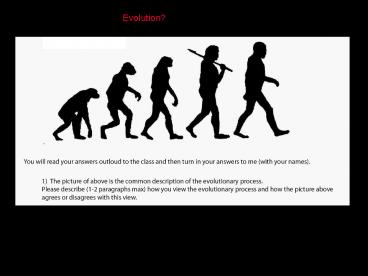Chapter 14 Definitions of the Gene - PowerPoint PPT Presentation
1 / 34
Title:
Chapter 14 Definitions of the Gene
Description:
Evolution? * How could we use GFP fluorescence to figure out-codon optimize GFP? * * * * * * * * * * * * * * * * * * * * * * * * * * * * * * The Molecular Basis of ... – PowerPoint PPT presentation
Number of Views:81
Avg rating:3.0/5.0
Title: Chapter 14 Definitions of the Gene
1
Evolution?
2
(No Transcript)
3
The Molecular Basis of Mutation-Evolution
- Mutations alter the nucleotide sequences of genes
in several ways, for example the substitution of
one base pair for another or the deletion or
addition or one or a few base pairs.
4
Tautomeric Shifts
5
Tautomeric Shifts AffectBase-Pairing
6
Mutation Caused by Tautomeric Shifts
7
Base Substitutions
- A transition replaces a pyrimidine with another
pyrimidine or a purine for another purine. - A transversion replaces a pyrimidine with a
purine or a purine with a pyrimidine.
8
Frameshift Mutations
Previously discussed
9
Factors Influencing the Rate of Spontaneous
Mutations
- Accuracy of the DNA replication machinery
- Efficiency of the mechanisms for the repair of
damaged DNA - Degree of exposure to mutagenic agents in the
environment
10
Induced Mutations
- Induced mutations occur upon exposure to physical
or chemical mutagens. - Hermann J. Muller and Edgar Alternburg measured
the frequency of X-linked recessive lethal
mutations in Drosophila. - Muller demonstrated that exposing Drosophila
sperm to X-rays increased the mutation frequency.
11
Chemical Mutagens
12
Types of Chemical Mutagens
- Chemicals that are mutagenic to both replicating
and nonreplicating DNA (e.g., alkylating agents
and nitrous acid) - Chemicals that are mutagenic only to replicating
DNA (e.g., base analogs and acridine dyes)
13
A Base Analog5-Bromouracilit is more like
Thymine!
14
Mutagenic Effects of 5-Bromouracil
15
Nitrous Acid Causes Oxidative Deamination of Bases
16
Intercalation of an Acridine Dye Causes
Frameshift Mutations
17
Alkylating Agents
- Alkylating agents are chemicals that donate alkyl
groups to other molecules. - Alkylating agents induce transitions,
transversions, frameshifts, and chromosome
aberrations. - Alkylating of bases can change base-pairing
properties. - Alkylating agents can also activate error-prone
DNA repair processes.
18
Hydroxylamine
- Hydroxylamine is a hydroxylating agent.
- Hydroxylamine hydroxylates the amino group of
cytosine and leads to GC ?AT transitions.
19
The Electromagnetic Spectrum
- X-rays induce mutations through ionization.
- Ultraviolet light induces mutations through
excitation- Energy addition.
20
Irradiation Dosage and Mutation Frequency
21
Ionizing Radiation Causes Changes in Chromosome
Structure
- Ionizing radiation breaks chromosomes and can
cause deletions, duplications, inversions, and
translocations. - These types of mutations display two-hit kinetics.
22
Mutagenesis by Ultraviolet Irradiation
Thymine Dimers
- Hydrolysis of cytosine to a hydrate may cause
mispairing during replication - Cross-linking of adjacent thymine forms thymidine
dimers, which block DNA replication and activate
error-prone DNA repair mechanisms.
23
Mutations Induced by Transposons
Wrinkled Pea
24
Expansion of Trinucleotide Repeats
Previously discussed
- Simple tandem repeats are repeated sequence of
one to six nucleotide pairs. - Trinucleotide repeats can increase in copy number
and cause inherited diseases. - Examples Fragile X Syndrome, Huntington disease,
spinocerebellar ataxia - These diseases are characterized by anticipation,
the increased severity of disease or earlier age
of onset in successive generations as the
trinucleotide copy number increases.
25
- Mutations are induced by chemicals, ionizing
irradiation, ultraviolet light, and endogenous
transposable genetic elements. - Point mutations are of three types
- Transitionspurine for purine and pyrimidine for
pyrimidine substitutions, - Transversionspurine for pyrimidine and
pyrimidine for purine substitutions, and - Frameshift mutationsadditions or deletions of
one or two nucleotide pairs, which alter the
reading frame of the gene distal to the site of
the mutation.
You must know for your future
26
Evolution?
27
(No Transcript)
28
(No Transcript)
29
(No Transcript)
30
Alpha and Beta chain mutantssome of them
31
Phylogenetic relationships
32
(No Transcript)
33
(No Transcript)
34
How could we use GFP fluorescence to figure
out-codon optimize GFP?































